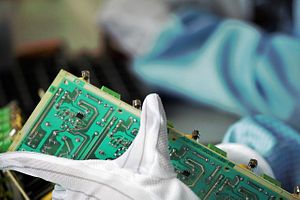The world’s technology-leading democracies must take a fresh approach to high-end tech exports and policy to prevail in the competition with China. The global semiconductor industry is an illustrative case study. As part of its Made in China 2025 initiative — a wide-ranging industrial policy intended to vault China into the select club of global technology powers — Beijing seeks to wean itself off dependence on foreign sources for semiconductor manufacturing and position itself as an independent semiconductor powerhouse.
This technonationalism strategy is ambitious. Semiconductors are particularly vexing because they require extensive know-how and meticulous manufacturing practices. To build its own semiconductor foundries, China is dependent on foreign semiconductor manufacturing equipment — the machinery needed to produce semiconductors — made by companies in just a handful of countries. The United States, Japan, and the Netherlands account for 90 percent of global market share.
This small group of partner countries has considerable leverage over China if they wish to maintain their edge in sophisticated hardware that forms the backbone of modern military and economic power. Multilateral export controls on semiconductor manufacturing equipment would protect their lead in global semiconductor design and preserve these countries’ collective competitive edge.
Last year, news broke that Dutch company ASML was delaying shipment of one of its products — an extreme ultraviolet (EUV) lithography device — to Chinese semiconductor firm SMIC, supposedly due to U.S. pressure. This is a big setback for SMIC because the EUV device is central to China’s strategy to closing the semiconductor technology gap and indigenize cutting-edge chip production. ASML is the sole manufacturer of EUV equipment required to make the most advanced semiconductors.
It is not surprising that U.S. authorities would lean on their Dutch counterparts to deny China this cutting-edge equipment as a salvo in the broader Sino-U.S. great power competition. The challenge for the United States is to convince the Netherlands to ultimately forego sales of such equipment to China. ASML’s 2018 annual report shows that China is an important market and accounted for most of its revenue growth. Given that a single EUV machine costs around $120 million, the stakes for the company are high.
The United States also wants TSMC, Taiwan’s largest chipmaker, to place stricter controls on its exports to China. Of special concern are TSMC’s sales — totaling 10 percent of its third quarter revenue in 2019 — to Chinese telecommunications firm Huawei, which the U.S. government views as a major national security threat. Hardware is clearly at the center of the technology competition with China.
The United States must assure its allies and partners there are ways to promote a vibrant high-technology ecosystem, with ample sales growth, while still safeguarding their technological edge over China. One way is to create a semiconductor fab consortium, consisting of the like-minded countries that produce and consume much of the world’s chipset output. These countries — such as the United States, Germany, France, South Korea, Japan, and the Netherlands — could collaborate to set up new semiconductor foundries outside of China. The benefits would be three-fold: introducing much-needed supply chain diversity and security; burden sharing of the cost of establishing new fabs, which cost $10-20 billion each; and helping companies to offset revenue lost from semiconductor manufacturing equipment sales to China by supplying the new facilities.
This should be part of a broader initiative to create a new international technology policy regime. The position of the world’s democracies as global technology leaders is increasingly at risk. On the current trajectory, China could surpass the United States — still the world’s tech leader — in critical technologies over the next 10 to 15 years, including in quantum computing, artificial intelligence, and genomics. Such a result would confer China with substantial economic, military, and political advantages.
In response, the world’s leading democracies and technology powers — 10 to 12 countries such as the G-7 countries along with like South Korea, the Netherlands, Australia, Finland, or Sweden — should not go it alone in this 21st-century technology competition. These nation’s individual efforts to spur innovation and to protect key areas of competitive advantage are far more likely to succeed if major elements of technology policy are coordinated and jointly implemented with allies and partners. Today, such coordination is sporadic, reactive, and ad hoc.
Broad-based, proactive, and long-term multilateral cooperation among like-minded countries is needed to maximize effectiveness across a range of areas, including R&D, supply chain diversity and security, standards-setting, multilateral export controls, and countering the illiberal use of advanced technology.
Working in tandem, this group can coordinate multinational technology policy to regain the initiative in the global technology competition through strengthened cooperation between like-minded countries; protect and preserve key areas of competitive technological advantage; and promote collective norms and values around the use of emerging technologies.
The United States, its allies, and partners cannot afford to sit idle. A new international organization for technology policy is needed. Technology-leading liberal democracies should spearhead its creation.
Martijn Rasser is a senior fellow at the Center for a New American Security. He is a former CIA officer.

































